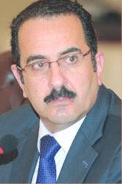
Energy demand in the Palestinian territories is growing rapidly while the availability of natural resources is scarce, making the power sector almost entirely dependent on energy imports from neighboring countries. Electricity demand is forecasted to grow by 6 percent annually until 2030, with the Israeli Electricity Corporation (IEC) being the largest supplier of electricity, providing the West Bank with 99 percent and Gaza with 64 percent of the total supply.
The Palestinian Energy and Natural Resources Authority (PENRA) aims to improve energy security by diversifying its sources of electricity and reducing the country’s dependence on imported power supply; increasing the use of renewable sources of energy that are available to increase the share of clean power in the overall energy mix of the country; and attracting private-sector participation (PSP) in the renewable energy sector. The Palestinian territory has a high potential for solar power generation, as it receives around 3,000 hours of sunshine per year. As a result, the Palestinian Authority is looking to attract investments in the renewable energy sector.
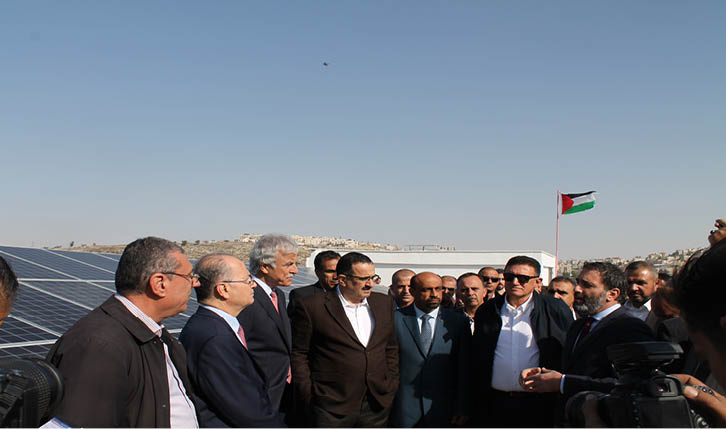
The energy problem in Palestine is one of many issues that affect the social and economic conditions of the Palestinian people. The fact that most of the energy is imported at relatively high prices places more financial burdens on poor and marginalized people. On average, households spend nearly 34 percent of their income on food and around 8.5 percent on energy (electricity and liquid gas). This reflects the vulnerability of Palestinians, especially the poor and marginal segments, and limits their ability to obtain the energy they need for daily use.
Furthermore, the fact that the electricity used in the West Bank and Gaza Strip is entirely controlled by Israel, either directly or indirectly, increases the complexity of the situation and the energy insecurity of Palestinian communities at large. In Gaza, the only power generation currently used is fossil fuel. Palestinians used to generate nearly 100 megawatts (Mw) of electricity from the Gaza power plant compared to their annual needs of 420 Mw. The locally produced quantity has considerably decreased, however, due to Israel’s repeated bombardment of the electric power station, while the portion that can be produced is dependent as well on Israel’s control of the fuel supply to Gaza. The fuel quantities allowed to enter Gaza are sufficient to produce nearly 65 Mw of energy, which is equivalent to only 15 percent of the electricity demand in Gaza. The situation in the West Bank is better, relatively speaking, but there are still some 65 communities that either lack a reliable power supply or have no power supply at all.
Electricity supply and demand
According to the Palestinian Central Bureau of Statistics (PCBS), the total electrical energy consumption in Palestine in 2019 was reported to be 5,929.5 GWh. This quantity is almost entirely imported from outside sources, mainly from the Israel Electric Corporation (IEC), as shown in Table 1.

The West Bank is mainly supplied by three 161/33 kV substations: one in the south close to Hebron; another one in the central West Bank, near the town of Salfeet, close to Nablus; and a third in the northern part of Jerusalem.
The electricity supplied by different sources is managed by local Palestinian companies, municipalities, committees, cooperatives, and associations. The largest of these are the Jerusalem District Electricity Company (JDECO), the Hebron Electric Power Company (HEPCO) that serves the southern areas around Hebron, the newly formed Southern Electric Company (SELCO) that serves the rest of the southern area, the Northern Electricity Distribution Company (NEDCO) that is being established to serve the northern area, the Tubas Electricity company (TDECO), and the Gaza Electric Company (GEDCO).
The available power capacity does not meet the demand in all Palestinian areas. Lack of electricity and the high cost of imported electric power are the main factors in the low Palestinian consumption of electric power. According to PCBS, the monthly average household electricity consumption (based on consumption during January 2020) varies from 285 kWh in Gaza to 482 kWh in the central West Bank. Moreover, the domestic sector is responsible for the bulk of electricity consumption, followed by the commercial sector.
The electricity demand in the Palestinian areas has doubled in the last decade. The peak demand usually occurs during winter when people use electricity for indoor heating. Peak demand is of particular significance, especially when there is a lack of fuel for use in indoor heating instead of electricity. Summer involves another peak demand period, manifested in the need for air conditioning that leads to additional electricity consumption.
While peak demand is expected to grow, it is also projected that demand for electricity will increase in the coming decade due to population growth, urban expansion, and development of commercial and industrial activities.
Potential solar energy production in Palestine
The main Palestinian cities and urbanized areas are interconnected by a relatively dense road network. Good accessibility is a precondition for an efficient energy network based on the exploitation of solar resources. From the point of view of natural geographic conditions, photovoltaic (PV) installations are optimally located on slightly inclined terrain, which is oriented to the south and has few natural pollution sources (e.g., sand, bare land); it is available in both the eastern and western parts of the West Bank and on the eastern side of the Gaza Strip.
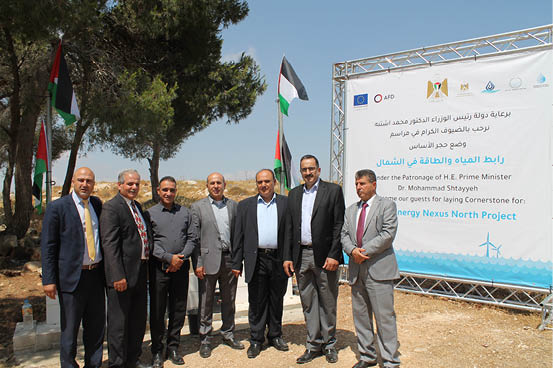
Optimal locations for PV systems can be advised in areas that are not too windy or on the hills where winds could have a positive effect on the systems’ performance. In locations such as the western part of the West Bank, winds have a cooling effect on PV modules. Locations in the Gaza Strip where the average wind speed is higher, as well as in the eastern West Bank, where wind can bring dust or pollution from urbanized, desert, and agricultural areas, are not preferred areas due to the fact that wind in these regions commonly has a negative effect because it increases dirt on the surface of PV modules, thereby reducing efficiency and increasing operation and maintenance costs.
The potential of electrical production and the performance ratio of PV power plants, considering climatic conditions for sites in areas with different irradiation levels, is shown in Table 2. In Palestine, the average values of specific PV power production from a reference system, described in Table 2, vary between 1700 and 1765 kWh/kWp for the selected three areas. A maximum value of energy that can be produced in Gaza and in the very southern region of the West Bank is higher than 1800 kWh/kWp.
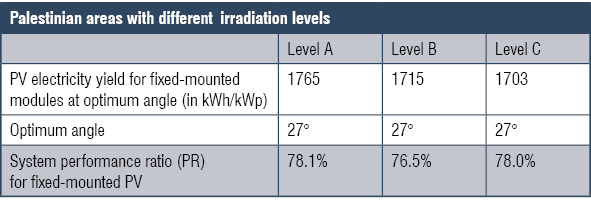
Policies and strategies
The Palestinian Energy Authority issued a renewable energy strategy in 2012 that aims to gradually achieve 10 percent of electricity production from renewable sources by the end of 2020. According to the strategy, this goal can be achieved if certain prerequisites are attained. The first prerequisite was the approval of legislation and regulations to apply and promote relevant technologies. The second was the adoption of both the necessary financial sources to remunerate incentives and feed-in tariffs which could foster investments from the private sector. The third prerequisite was to build the capacity of the workforce so that it has the basic skills to apply and deal with renewable technologies. The fourth was the adoption, improvement, and construction of a plan for renewable energy sources that would last until December 2020.
According to the strategy, it is foreseeable that 130 Mw would be installed from renewable resources projects by the end of 2020, and the major portion of green power would be generated by solar energy. The strategy comprises two phases. The first phase involves conducting feasibility studies and preparing bids for the Palestinian market, as well as deploying small-scale projects and implementing the Palestinian Solar Initiative. The first phase was implemented between 2012 and 2015 and aimed to attain 25 Mw from predetermined sources of renewable projects.
Over the last years, several key support schemes necessary for the uptake of renewables have been introduced in Palestine, namely, a feed-in tariff (FiT) scheme, a net metering scheme, a licensing scheme, and a tendering scheme.
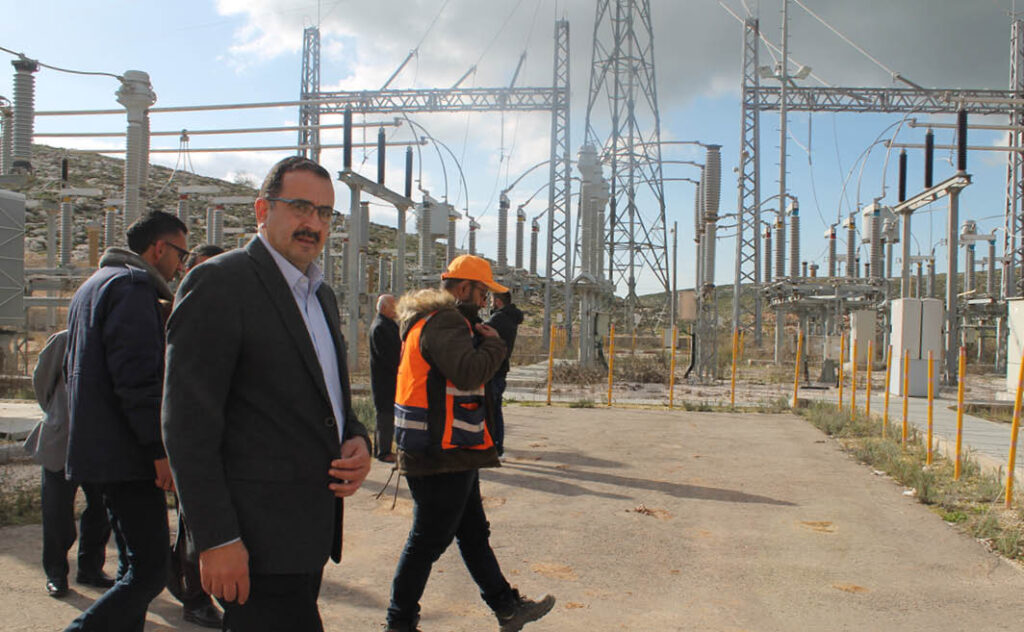
A new National Renewable Energy Action Plan (NREAP) (the new plan or strategy from 2020 to 2030) for Palestine is in the preparation stage and outlines the strategy to further accelerate the deployment of renewable energy technologies. It defines the targets for the various sectors and describes the measures that have been and will be put in place to reach those targets. It will give customers, the commercial RE sector, the administration, and national and international investors and financing institutions, as well as other stakeholders a thorough basis on which to plan their activities.
The NREAP proposes the following new RE targets:
- December 2020 target: 100 Mw, mostly PV
- 2030 target – scenario A: 300 Mw, including only areas A and B
- 2030 target – scenario B: 500 Mw, including areas A, B, and C
Eighty percent of the 2030 targets will be achieved with solar PV, 10 percent with wind energy, and 10 percent with biogas/biomass.
Legal and regulatory environment
The most recent relevant law in Palestine is the Decree Law on renewable energy and energy efficiency, issued in 2015. Article 2 of the Decree Law states that its objective is to encourage the utilization and application of renewable energy sources to increase their contribution to the total energy balance and achieve secure energy provision in line with the renewable energy strategy. It also addresses the issues of environmental protection and fulfilling the sustainable development requirements. The Decree Law specifies the roles and responsibilities of the various institutions and bodies involved in energy regulation and in the monitoring, production, distribution, and transfer of energy. It also describes the role and responsibility of the Energy Research Center in conducting research to define the best alternatives and locations for renewable energy production and in raising awareness and building capacity in this sector. Although Article 18 of the Decree Law encourages the investment in renewable energy production by granting it all the privileges that the investment law provides, Article 12 of the Decree Law restricts the production for commercial purposes for a limited period, to be regulated by a license. It also does not define the FiT that electric companies should apply for generated electricity from renewable sources and left it to be adopted by the Council of Ministers upon the Energy Authority’s recommendation.
The second relevant law is the Electricity Decree Law No. 13 that was issued in 2009 with the main objective of restructuring and improving the electricity sector and of fostering national and foreign investment to obtain an adequate power supply and properly priced services. The law stipulates the establishment of an electricity regulatory council and identifies the council’s duties and responsibilities.
The Decree Law is the first step in sector regulation and in achieving a new structure. In addition, the Electricity Decree Law stipulates the establishment of a fully government-owned National Transmission Company. The company is obligated to allow generators and suppliers to use the national grid. It also authorizes the purchase and selling of power from any source and allows for reselling the purchased power to distribution companies.
With regard to renewable energy sources, the Electricity Decree Law explicitly states that PENRA must work to encourage research on alternative energy sources and regulate its exploitation through bylaws.
Electricity prices and PV systems in Palestine
For a 1 MwP on-ground structured PV power plant, based on local market price ratings, the capital expenditure amounts to US$0.9 to 1.1 million, including modules, inverters, electrical cabling, mounting structure, civil work, installation, and engineering cost. The operating expenditure is estimated at US$32,000, including operation and maintenance with five cleaning cycles, spare parts, inverter maintenance, and power lines, in addition to insurance and administrative costs.
Conclusions and recommendations
• The current electricity supply level is not sufficient to cover the needs in all areas of the West Bank and Gaza Strip, and more than 65 communities still either lack adequate electricity or are not connected to the electricity grid. In the meantime, the supply in Gaza is not sufficient at all, resulting in a policy whereby electricity is made available by rotation among various areas for a duration of 4 to 6 hours.
• The electricity consumption is higher in the areas with higher population, which indicates that households are responsible for the main electricity consumption, followed by commercial and light industrial activities.
• Solar radiation is best in the central and southern parts of the West Bank and Gaza, with the highest values in Gaza and the lowest in Jericho.
• Land availability and financial concerns constitute the main challenges to investment in large solar energy projects.
• Investing in renewable energy projects is economically and environmentally feasible. Yet, to encourage the development and investment in this sector, a clear incentive policy needs to be developed in order to attract investors, present guarantees and security, and provide more incentives such as low-interest loans, tax exemptions, and more.
• Empty spaces in the southern West Bank on southeastern slopes should be utilized to generate electricity from solar energy and meet the growing demand in the Hebron area, given that the highest demand is recorded there. In the meantime, due to space limitations in Gaza, the roofs of public buildings, light industrial establishments, greenhouse tops, etc. should be utilized to generate more electricity from solar energy.
• To comply with the strategic target of generating 10 percent of the electricity demand from renewable energy, as proposed by the Palestinian Energy Authority in the newly drafted strategy (2020–2030), 500 Mw must be installed over the planning period by 2030. The investment required to install this quantity – considering that PV panels must be adequately spaced and placed at an inclination of 27 degrees on around 7,000 dunums of land – adds up to nearly US$650 million, if the land required for the investment is rented. If we consider buying the land, assuming that the average price per dunum in the eastern slopes is nearly US$12,000 (possibly much less depending on the area), we must add approximately US$84 million to the investment, reaching a total investment amount of approximately US$734 million over the coming 10 years.
• The investment required for the installation of renewables will be funded by private project developers and donors – rather than the government – provided that stable support schemes are kept in place. Palestine has introduced several schemes that support the uptake of renewables, such as a FiT scheme, a net metering scheme, and a licensing (or “direct offer”) scheme, while a tender scheme is in the preparation stage. The availability of these schemes can be considered very positive, even though their implementation still requires further actions, commitment, and increased ambition.
• Some 90 Mw of solar PV are estimated to have been installed to date, generating less than 3 percent of the electricity demand.

